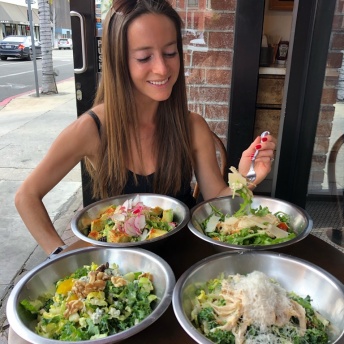









Whether you have a gluten intolerance or celiac disease, you must be incredibly careful with what you eat. This goes for eating out in restaurants and choosing which products to eat at supermarkets. I created Gluten Free Follow Me to help others navigate the confusing world of gluten-free eating. I will never tell you what you should or should not eat. I share what I feel comfortable eating and how I live my gluten-free life. My website is simply a guide that describes what I eat – everything is up to your discretion.
I think that it is worthwhile to describe in detail what I look for when eating out or buying products to make myself feel comfortable with what I put into my body. There are people who will only eat in strictly gluten-free restaurants and others who are much more relaxed than I am with what they will allow themselves to eat. That is okay – I’m not here to judge anyone. I just want you to understand the criteria I use and feel comfortable with when I make a recommendation.
Restaurants:
Thankfully, there are some eateries that represent themselves as 100% gluten-free and thus should be safe for those with gluten-free intolerance and celiac disease. Here is a list of the 100% gluten-free restaurants I’ve reviewed. I’ve been to over 70 completely gluten-free eateries, and it’s very comforting to dine there. There are also other eateries that take precautions to keep their kitchen as gluten-free friendly as possible. You can customize your own restaurant searches for 1,500 restaurants here.
If you have celiac disease and only feel comfortable eating out at a 100% gluten-free restaurant, that’s understandable and completely up to you. If you don’t want to eat out at all, that’s also your choice. Eating at a 100% gluten-free eatery is always preferred, but there are many non-100% gluten-free restaurants that I feel comfortable eating at and recommend on my website. To dine out safely, you must know what to avoid, the hidden sources of gluten, and how to avoid cross-contamination with gluten.
My Restaurant Procedure:
- Contact the restaurant beforehand to see if they are gluten-free friendly. Ask if they offer gluten-free options such as gluten-free bread, pasta, pizza, and dessert. I’ve found that many restaurants offer gluten-free options but don’t always list them on their menu. This is one of the reasons I detail the gluten-free options on my website and include any nuances. Each restaurant profile on my website says if the eatery offers a gluten-free menu, bread, pizza, and/or pasta so you know before dining. You would think that all restaurants would want to market that they are gluten-free friendly if they are, but I’ve seen places shy away from sharing their gluten-free options unless directly asked by a gluten-free customer. Some eateries include disclaimers that they are not a “gluten-free kitchen” which is true of all places that are not 100% gluten-free. I still feel comfortable eating at many restaurants that do not have fully gluten-free kitchens, but the end decision is up to you.
- When I get to the restaurant, I immediately tell my waiter that I am gluten-free. Do not be embarrassed to say that you are gluten-free. It’s much worse if you order something that you think is gluten-free, and it isn’t. You then face the risk of getting sick. You can never assume that something is gluten-free because menus typically don’t include all of the ingredients for each dish. I’ve even run across scenarios where chefs add flour as a thickening agent without disclosing it on the menu. For example, crème brûlée, panna cotta, and chocolate mousse are naturally gluten-free desserts but some restaurants add flour to them.
- I ask the waiter a lot of questions. I make it very clear that my meal needs to be a safe gluten-free meal. If the server does not understand, ask to speak to the manager or chef. Some of the questions I ask are:
- Do you have a gluten-free menu?
- What are your gluten-free options?
- Do you know what gluten is?
- Are there any dishes with potential cross-contamination risk?
- Does the salad come with croutons, wontons, or anything crispy or fried?
- Does the salad dressing or soup contain gluten or flour?
- Has the food been marinated in any sauce? Is the sauce gluten-free?
- Does bread come with my dish?
- Do you have a dedicated gluten-free fryer?
- I only eat fried food that is prepared in a dedicated gluten-free fryer. Some eateries may indicate that their fries are gluten-free. I always double-check that they are made in a separate fryer in order to avoid cross-contamination.
- If a restaurant offers gluten-free pizza crust, I ask how the pizza is prepared and cooked. Ideally, the restaurant will have a dedicated gluten-free pizza oven. If not, I always ask them to cook my pizza on a separate tray. I will not eat a pizza that is placed directly on a pizza oven that cooks gluten pizza. You should also ask about the pizza ingredients. Many pizza spots have separate containers for gluten-free toppings, sauces, and serving spoons. At most fast-casual pizza spots, if you tell them that you are gluten-free, then they will automatically change their gloves and prepare your pizza separately.
- If a restaurant offers gluten-free pasta, I ask how the pasta is prepared and if it’s cooked in a dedicated gluten-free pot.
- If a restaurant offers gluten-free bread, I ask if they have a dedicated gluten-free toaster. I only get my bread or bagel toasted if it’s in a dedicated gluten-free toaster.
- If a restaurant doesn’t have gluten-free bread or buns, ask for a burger without the bun or served on top of greens or as a lettuce wrap. Note that most veggie burgers contain gluten so make sure the patty you’re getting is indeed gluten-free. Beef and turkey patties are typically gluten-free, but again always ask.
- When you read the menu, look out for the following key words which may indicate gluten:
- crispy {usually means fried and can be fried in the same fryer as gluten-containing items}
- soy
- tempura
- crab {most places use imitation crab which typically isn’t gluten-free}
- eel sauce
- teriyaki
- creamy
- marinated
- dressing
- spicy
- Take a moment to fully examine your food before eating it. For example, if a dish you ordered was supposed to come with bread, and they don’t offer gluten-free bread, then be vigilant. If it looks like a piece of bread was on your plate and then removed (maybe you see crumbs or the plate looks a bit off), send it back.
- If there aren’t too many gluten-free options at a restaurant, salads and egg dishes are typically safe items. For salads, request balsamic vinegar and olive oil for your dressing, and make sure there aren’t any croutons or breadcrumbs in the salad. Make sure that your omelet or egg dish doesn’t come with bread because many places will add that on automatically. You can also request fish and meat to be simply cooked aka with just olive oil, salt, and pepper. Gluten can hide in sauces so the simpler, the better.
You always have the choice to opt out of the meal all together if you don’t feel comfortable. Bottom line: understand what it means to be gluten-free, research the eateries (Gluten Free Follow Me is a great source for this), ask the right questions, and bring an alternative snack.
How I Eat Products:
I prefer when brands are certified gluten-free and made in a dedicated gluten-free facility. I also will eat most products that are naturally gluten-free, with some exceptions. You can customize your own product searches across 950+ brands here. You can filter these 950+ products by certified gluten-free, made in a dedicated gluten-free facility, naturally gluten-free, and gluten-free options. I try to give you as much information as possible in order for you to make the best decision for you and your body. As always, only eat what you feel comfortable eating.
It’s important to read the labels of everything you consume. Many brands will label their products as gluten-free to make it easier for you but you still need to investigate further. It’s important to read the entire ingredient label and not just rely on the allergen disclaimer. Even if you ate this product before, production procedures and ingredients can change at any time. Check the ingredient label for the following key words which generally means GLUTEN:
- wheat
- barley
- rye
- malt
- malt flavoring
- maltose
- bulgur
- farro
- spelt
- wheat starch
- wheat bran
- wheat germ
- couscous
- cracked wheat
- durum
- einkorn
- emmer
- semolina
- triticale
- farina
- fu
- gliadin
- seitan {meat substitute using in some vegetarian dishes}
- Brewer’s yeast
- oats {oats themselves don’t contain gluten but are usually processed in facilities that produce gluten-containing grains and may be contaminated so I only eat certified gluten-free oats}
- oatmeal
- oat bran
- oat flour
- graham flour
- kamut
- matzo
- soy sauce
If you are unsure whether a product is gluten-free, contact the manufacturer for clarity on their ingredients and what they do to prevent cross contamination.
In Conclusion:
Following a gluten-free diet can be difficult at times. I truly believe that knowledge is power. The more you know and understand, the easier it gets. You CAN enjoy eating out at a restaurant and simply browsing products in the supermarket! Let me know about your gluten-free experiences and other things you look for when eating out.


























